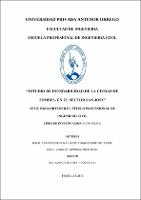Mostrar el registro sencillo del ítem
Estudio de inundabilidad de la ciudad de Tumbes - en el sector San José
| dc.contributor.advisor | García Rivera, Juan Pablo | |
| dc.contributor.author | Zapata Espinoza, Grethy Madeleine del Cisne | |
| dc.contributor.author | Zárate Espinoza, Nick Joan | |
| dc.creator | Zapata Espinoza, Grethy Madeleine del Cisne | |
| dc.date.accessioned | 2019-12-04T14:49:10Z | |
| dc.date.available | 2019-12-04T14:49:10Z | |
| dc.date.issued | 2017 | |
| dc.identifier.uri | https://hdl.handle.net/20.500.12759/5733 | |
| dc.description.abstract | Este trabajo de investigación se realizó con la finalidad de determinar los criterios técnicos para realizar la simulación del recorrido de las aguas del río Tumbes por las diferentes calles y/o avenidas en el momento de su desborde y del control de volúmenes en función de los caudales que ingresan con el fin de generar un modelo de predicción aplicable a distintos intervalos de tiempo y caudal; teniendo como objetivos la elaboración de un modelo hidráulico mediante el programa IBER con la finalidad de simular el comportamiento y desplazamiento del río Tumbes. Se usa el método inductivo, con toma, registro y procesamiento de datos para realizar el modelamiento utilizando softwares de ingeniería. Teniendo como resultado de la granulometría un D50 = 15 mm, pendiente de zona del proyecto de 0.00443 m/m, ancho estable de 130 m, caudal de diseño de 3,690.76 m3/seg para un periodo de retorno de 50 años y el modelo hidráulico fue comparado con el comportamiento real permitiendo cumplir el objetivo planteado. Y como principal conclusión es que el diagnóstico obtenido es que el Sector San José se inunda a causa de ser la zona más baja y plana de la ciudad de Tumbes y para finalizar presentamos una propuesta para la construcción de un dique con un área de 25.62 m2. | es_PE |
| dc.description.abstract | This work of investigation was realized by the purpose of determining the technical criteria to realize the simulation of the tour of the waters of laughed Fall down for the different streets and / or avenues in the moment of his overflow and of the control of volumes depending on the flows that enter in order generates a model of prediction applicable to different intervals of time and flow; taking as aims the production of a hydraulic model by means of the program IBER with the purpose of simulating the behavior and displacement of he laughed Fall down. The inductive method is used, with capture, record and processing of information to fulfil the modelamiento using software’s of engineering. Taking as a result of the granulometry a D50 = 15 mm, earring of zone of the project of 0.00443 m/m, stable width of 130 m, flow of design of 3,690.76 m3/seg for a return period of 50 years and the hydraulic model was compared with the royal behavior allowing to fulfill the raised aim. And it is like a principal conclusion that the obtained diagnosis is that the Sector San Jose floods because of being the lowest and flat zone of the city of Fall down and to finish let's sense beforehand an offer for the construction of a dike with an area of 25.62 m2. | en_US |
| dc.description.uri | Tesis | es_PE |
| dc.format | application/pdf | es_PE |
| dc.language.iso | spa | es_PE |
| dc.publisher | Universidad Privada Antenor Orrego - UPAO | es_PE |
| dc.relation.ispartofseries | T_ING.CIVIL_1580 | |
| dc.rights | info:eu-repo/semantics/openAccess | es_PE |
| dc.source | Universidad Privada Antenor Orrego | es_PE |
| dc.source | Repositorio Institucional - UPAO | es_PE |
| dc.subject | Modelo hidráulico | es_PE |
| dc.subject | Desplazamiento del río | es_PE |
| dc.title | Estudio de inundabilidad de la ciudad de Tumbes - en el sector San José | es_PE |
| dc.type | info:eu-repo/semantics/bachelorThesis | es_PE |
| thesis.degree.level | Título Profesional | es_PE |
| thesis.degree.grantor | Universidad Privada Antenor Orrego. Facultad de Ingeniería | es_PE |
| thesis.degree.name | Ingeniero Civil | es_PE |
| thesis.degree.discipline | Ingeniería Civil | es_PE |
Ficheros en el ítem
Este ítem aparece en la(s) siguiente(s) colección(es)
-
Ingeniería Civil [1085]

